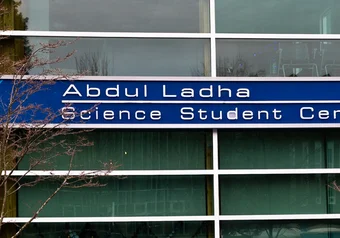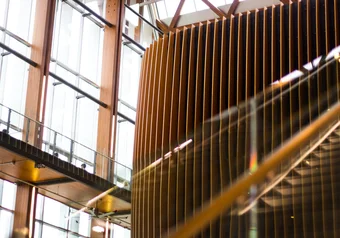Update Tuesday, June 5 at 4:40 p.m.: UBC Board of Governors’s Property Committee has granted the first Board approval to the project with a funding release of $500,000.
Over five years after students showed support for the creation of the Arts Student Centre (ASC), its construction is finally on the horizon — albeit with a $10 building fee increase as mandated in the 2013 referendum and at a different location.
The ASC is intended to be a stand-alone space for arts students on campus, akin to what Abdul Ladha is to science students or what the Engineering Student Centre does for engineering students.
AMS designer Michael Kingsmill, who is working with the Arts Undergraduate Society (AUS) on the project, expects construction to begin in July 2019 and finish by March 2021.
This timeline is still subject to three rounds of approval from the UBC Board of Governors (BoG) — the first one at the June 14 meeting, the second one in February 2019 and the third one in June 2019. Kingsmill is confident that the project will pass.
“Nobody wants to stall it because inflation is eating away [at the budget],” he said.
Progress on the project has accelerated recently after years in limbo. According to AUS VP Administration Jina Marwood, round two and three of executive planning were only completed in December 2017 and May 2018 respectively — despite the first round being done in December 2013.
She attributed the difficulty of maintaining the project’s momentum to the VP Administration role’s high turnover rate.
“We had a VP Admin who, like last year, was there [and] resigned because it was too much work. Then we had an interim VP admin and [they] ran for VP admin, won and then decided she’s not coming back to UBC,” said then-AUS President Adrian Talingdan in an October 2015 interview with The Ubyssey.
Seeing green
The new timeline is marked by a building fee increase from $15 to $25 for arts students. Mandated to take place at the project’s five-year point by the 2013 referendum, the jump will take effect in the upcoming winter term.
Student’s reactions to the upcoming increase seem split so far.
“I like it — arts student deserve some dedicated study space on campus that clubs have access to,” commented Reddit user maclockhart. “Meekison just doesn't have the facilities necessary to work on community for arts. Students now need to invest in the facilities for future students.”
“I don’t care if it’s a dollar increase — I don’t wanna pay it for something I won’t use considering I just go for classes and nothing else,” commented second-year student Wiki Molska on a Facebook post by The Ubyssey.
“Not to mention it won’t be completed til [sic] 2021 when I grad. So how about they figure their budget out.”
Marwood expressed that while she understands the frustration that some students feel about the increase, it is integral to the project.
“I think the fee increase is something I definitely want to talk about to students because I’m a student, I pay for my tuition, I know it sucks,” she said.
“But collecting the money at the time that the referendum states will eventually shorten the period of paying off the loan anyway so either way students are going to have to pay off that loan. So starting now, to me, isn’t a bad idea.”
Currently, the total cost of the ASC’s development is approximately $8.3 million — around $3 million more than originally projected in 2013. Kingsmill attributed this increase to “a very active construction industry” and inflation.
He noted that the AUS will not have to pay the full price because along with a $500,000 contribution from UBC, the faculty of arts is also pitching in $2.5 million. The society has also collected $1 million in building fees since 2013, which cannot be used for anything beside the ASC’s development.
“If anything should happen, which at this stage it will not, that money would have to be returned to students,” said Kingsmill. “But at this time, the money is accruing in the university’s treasury.”
Since this amount would grow by the time the project requires a construction loan, Kingsmill estimated the AUS would only have to borrow $4 million, which would be paid back over the course of 13 years. The $25 fee would be collected until the loan is paid off.
Altogether, given past criticism about the AUS’s financial management and limited attention to the project in the past few years, Marwood wants to use this fee increase as a conversation starter with students.
“I think the conversation is going to start when the fee increase rolls in, and we’ll have more of an open space to talk about why this is happening and what we’ve been doing for the past years,” she said.
“We want to be as transparent as possible.”
She also confirmed that while the society discussed a student fee increase from $13 to $25 last year, it won’t be implemented next year because of the ASC fee increase.
“[The student fee increase] is something that we’re not even going to bring to next year council but just as a platform for when we’re doing transition like, ‘Hey, these are the services that we did and here are ways that they can be improved and raising the budget may be beneficial’ — but that’s up to them,” Marwood said.
“We don’t want to compound a bunch of increases.”
Relocate and reanimate
The ASC's planned location is also changing. Originally slated to be in front of Brock Hall, it will now be built in the wooded area between the Life building and the Irving K. Barber Learning Centre.
Kingsmill has adjusted the the ASC’s design to reflect the new forested landscape, particularly by more wood to the building’s design. Amenities — like informal and formal study spaces, a public assembly space, a video conference room and an art gallery — will stay the same.
“The program, or the ingredient list of things, was cast in stone,” Kingsmill said. “That was what the survey says about the need of the society so we incorporate that into the program, and the program didn’t change as we move forward.”
While this new location was first mentioned by UBC — who views the Brock Hall site as a “prime academic space” — the AUS ultimately decided that it is a better fit for the ASC.
“[The new site] was just a better location, it was more centralized, it was ready to go right away,” said Marwood. “At the same time, the university wanted to hold [Brock Hall site] that we had just for academic and housing site use … so it was more of a simple switch with good timing.”
According to Michael White, associate VP of campus and community planning, UBC has not decided how to use the site near Brock Hall. He also noted that to help with the switch, the university is contributing $500,000 — which is sourced from infrastructure impact charges on mainly market developments — towards the ASC’s utility planning and relocation.
Part of the help will also go toward “reanimating” the surrounding space, which would include looking at designs for lighting, benches and pathways. “Adding more biodiversity” is another objective, especially to address the eight trees that would have to be removed to make space for the ASC.
“Right now, that area is dark and muddy and pretty unpleasant most of the year,” White said. “We’ll be doing planning work through this year and looking to next year with the actual execution of the improvements.”
Besides the ASC, the wooded area is unlikely to be slated for future development.
“The AMS is very much in favour of making sure that the green space is kept,” said VP Academic and University Affairs Max Holmes, who assisted the AUS with the relocation.
“The last thing we would want to do is to get rid of such a prime green space on campus when there has been a lot of development, and so the AMS would not be in favour of any other buildings in that space.”
Share this article
First online



![['']](https://storage.googleapis.com/ubyssey/media/renditions/ASS-Andrew-Hood.width-1000.format-webp.webp)
![['']](https://storage.googleapis.com/ubyssey/media/renditions/asc_options_-_for_website.width-1000.format-webp.webp)


